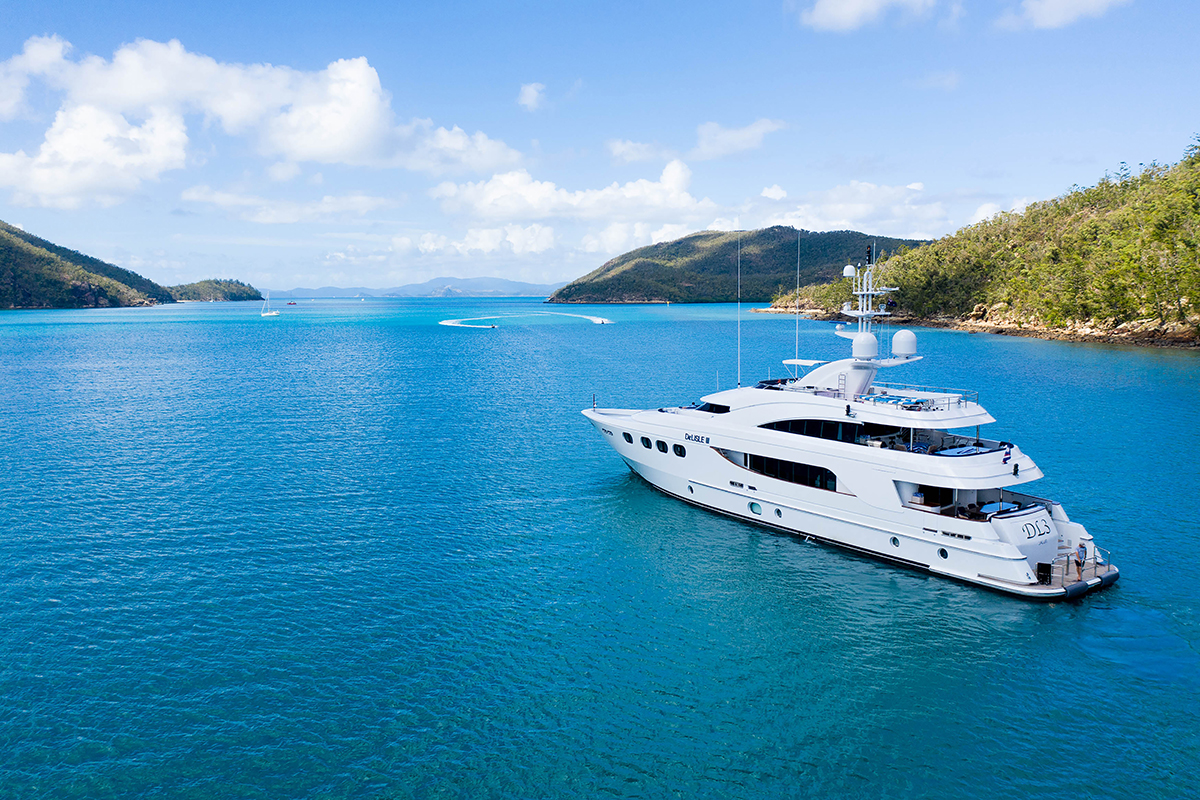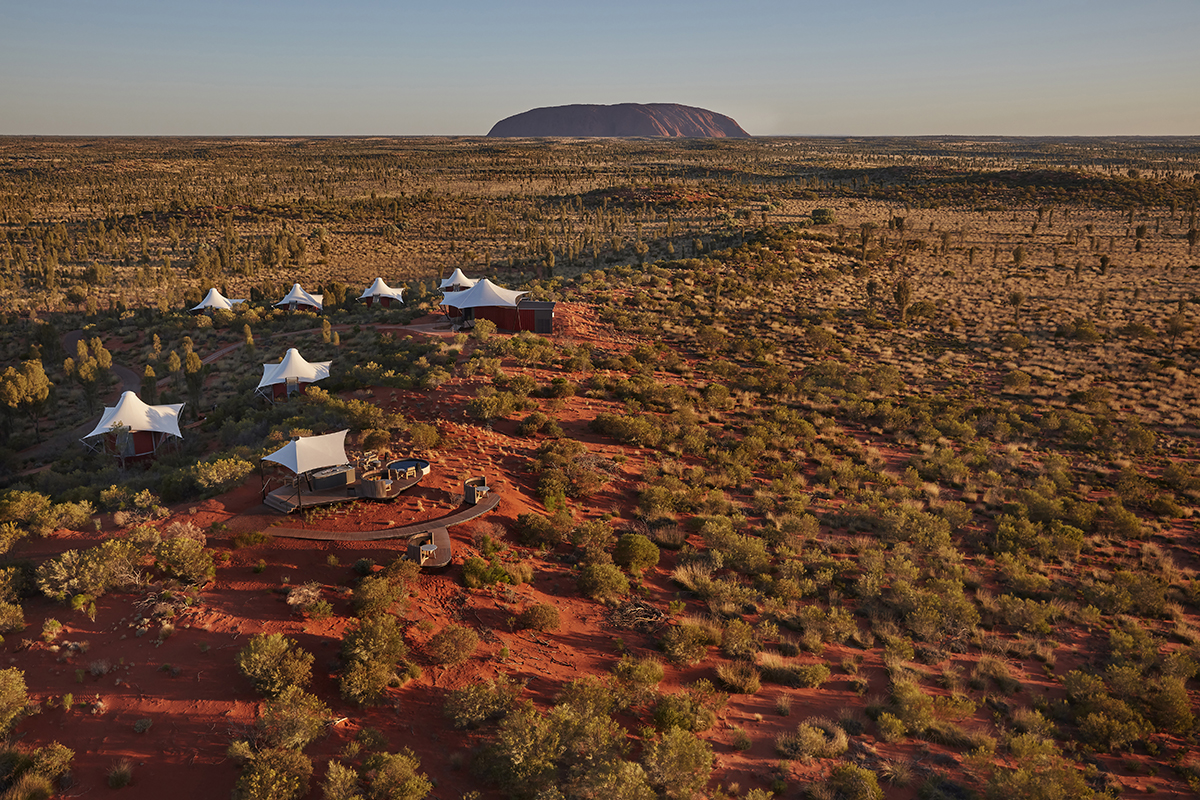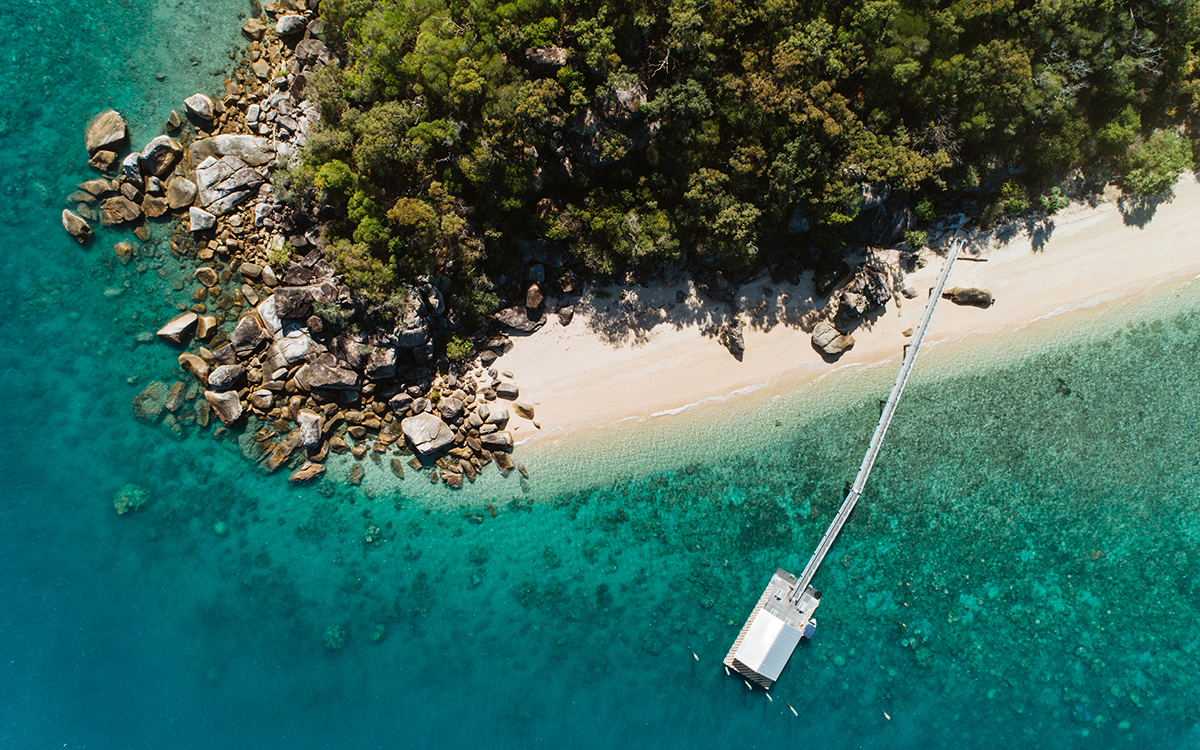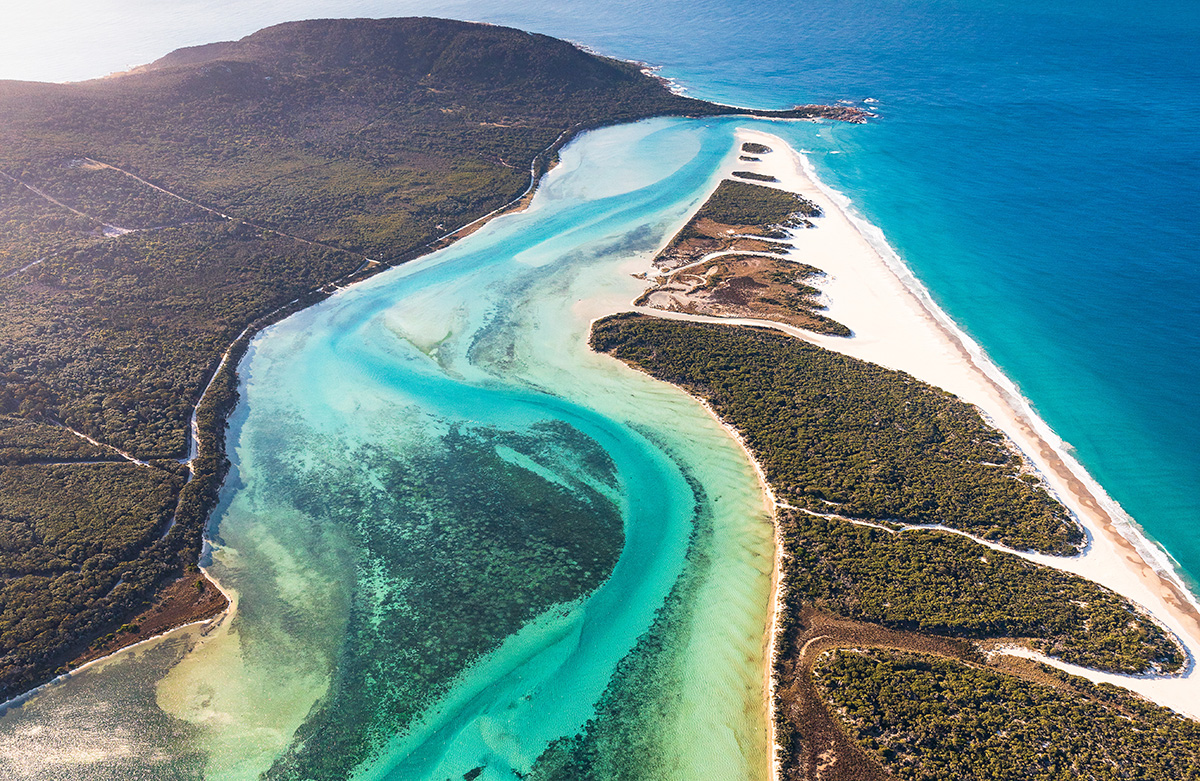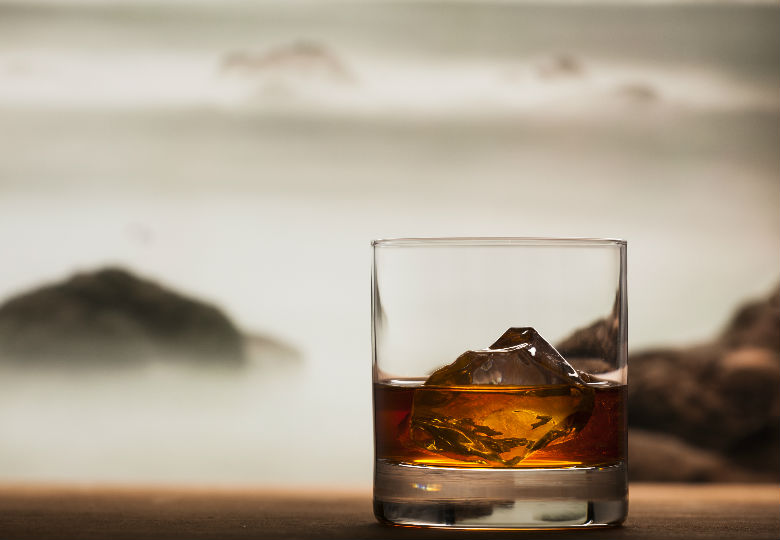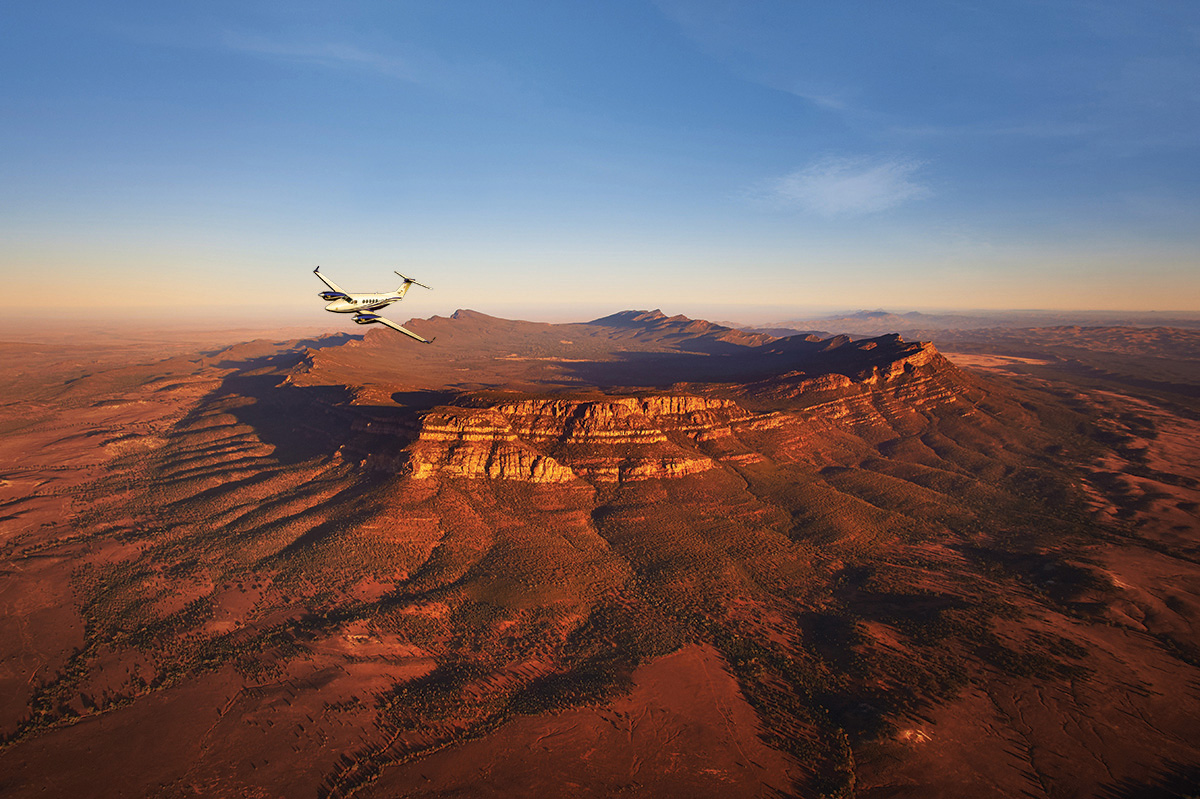
Eleven Luxury Domestic Travel Destinations
Discover the country’s most unique and engaging experiences — to dream (and book) now.
Related articles
Ultimate Outback Charter
At a time when distance is arguably the world’s greatest luxury, exploring the Australian outback in a private plane with just six other people could be considered the epitome of travel experiences. Abercrombie & Kent’s journey around South Australia doesn’t cut any corners—or compromise on style. Over eight days (pick between dates in August 2021 and March 2022), you’ll have the opportunity to glimpse attractions both from the air and on land en route.
Your journey begins in the Ikara-Flinders Ranges National Park—all red peaks, gorges and valleys of striated rock. Your pilot will take you low over Wilpena Pound before landing at Rawnsley Park Station, your base for the night and gateway to the rugged Bunyeroo and Brachina gorges, providing a window through 130 million years of the Earth’s history. Onwards you’ll visit Australia’s smallest town, William Creek, population 16. And then Coober Pedy, the country’s opal capital, where your accommodation for the night takes you deep underground—cave hotel, anyone?
Certain Australian sights bear an enormity that can only be grasped from the air: Kati Thanda, or Lake Eyre, is among these. Come sunrise, you’ll continue by gliding over this spectacle to witness the area’s surreal salt flats that shimmer all the way to the horizon. Your next destination is Mt. Ive Station, where Lake Gairdner’s own glistening salt pans cut a stark contrast against the hills of red sand that surround. The scenic whiplash continues as you reach Coffin Bay on the coast, and the brilliant blues of the Southern Ocean.
Swap sky for sea and cruise out to discover how the region’s Pacific and angasi oysters are grown and harvested, with dolphins, seals and seabirds as your travelling companions. Back on shore, national parkland reveals untouched beaches and dunes, bordered by ancient sandstone cliffs that cast long shadows over the land. Between here and Port Lincoln, your only diversion is for refreshments at a winery—more of which awaits at your final destination, the seafood capital of Australia.
Torres Strait By Superyacht
Set your super yacht’s GPS for about as far north as you can travel in Australia and you’ll reach the Torres Strait Islands, one of the world’s last true wilderness frontiers and a place that steals the soul with its sheer, unadulterated beauty. Off the tip of Cape York, the archipelago of 274 islands strings across the ocean between Queensland and Papua New Guinea, fringed by the northernmost reaches of the Great Barrier Reef—minus any of the crowds you’ll find snorkelling further south.
This remoteness guarantees nature writ large, whether on powdery beaches or atop volcanic peaks on drops of land that emerge from gin-clear water. The same blissful isolation means this part of the country is not easy to explore, unless you’ve chartered the shiny De Lisle III for $165,000 a week.
The price tag provides your group of 10 unfettered access to this 42-metre super yacht, custom fitted with teak and brass, and topped with an enviable jacuzzi for scenic soaks between anchor drops. Which may well be in the middle of nowhere, to snorkel with dugongs, dolphins, sea turtles and giant marlin, totally unperturbed by your presence—because they’ve likely never seen another human before. Then cruise out to more remote haunts to find hidden curves of sand, opaline bays and tiny villages that nurture Indigenous culture and traditions dating back more than 70,000 years.
Many Torres Strait Islands are also people-free, with only 20 inhabited and just a few others permitting visitors. Thursday Island, the area’s capital, is one; sleepy today, but once a bustling hub for pearling with hundreds of ships and divers based here. This part of the country—between Australia and the rest of the world—has also played a major role in defence over the decades, and you’ll still find decaying reminders of this heritage on far-flung outposts. Like Thursday Island’s 1891 Green Hill Fort, built to protect against a potential Russian invasion. And various gun emplacements, trenches and a wrecked aircraft on Horn Island, the only place in Australia where Aboriginal and European-descended soldiers served side by side.
This sobering reminder of the tragic past somehow makes the destinations you’ll sail to even more appealing; beauty can, it seems, survive and thrive, even when tested by the most extreme of human forces.
Exclusive Sitting At Chae
The most talked about newcomer in Melbourne dining, Chae is a six-seat Korean effort housed in an apartment in Brunswick. That’s right, an apartment—the small home of head chef Jung Eun Chae and her husband Yoora Yoon. This is intimate and elevated home cooking—impeccable in taste and unique in experience, something Australian dining is too often lacking. Book exclusive use and, with a group of friends or family, experience something you simply won’t
find elsewhere.
The Dreaming’, Kinara Spa, Longitude 131
Uluru is Australia’s spiritual heart, so it’s fitting that the most upscale lodge in these parts offers spa treatments that conjure blissful, soul-salving emotions. Under the gaze of the world’s mightiest monolith, exclusive Longitude 131° features tented villas scattered among native bushland. Prepare not to leave for three hours when you book “The Dreaming”, a reviving ritual based on philosophies tens of thousands of years in the making by the region’s Anangu people. It all begins with a body mud wrap of desert salts and yellow clay, for detoxification. Then you’ll ease into a Kodo (Aboriginal rhythmic) massage, scalp invigoration and lush facial, before ending your experience with a hand-and-foot treatment. Don’t forget to inhale along the way—products are infused with native ingredients including lilly pilly, munthari berry, quandong and wild rosella.
Exclusive Hire, Orpheus Island
The only way to reach Orpheus Island is a private helicopter transfer from Townsville, your sky-high chariot whisking you off the Queensland coast over a coral-studded sea.
As if your ride north wasn’t exclusive enough, on arrival you can have the entire retreat—all 14 luxurious rooms—to yourself and 27 of your closest friends for $25,000 a night.
In the middle of the Great Barrier Reef and set on 1,300 hectares of national parkland, the island and its only resort began life as a humble retreat in the 1950s—back then a favourite getaway among the likes of glam British actor Vivien Leigh, who came to switch off and bliss out.
Today, the design inspiration is Hamptons-chic, replete with sun-kissed rooms, suites and villas bedazzled in crisp whites, azures and emerald greens—think Robinson Crusoe meets The Ritz.
But the goal remains the same as when Leigh roamed the grounds—this is a place where you can disconnect from technology and reconnect with the nature that encompasses the resort.
First stop should be the world’s largest reef, the waters surrounding this island idyll churning with an astounding 1,100 of the Great Barrier Reef’s 1,500 species of fish, not to mention almost every single species of hard coral ever recorded. Strap on a mask and fins to swim with manta rays, sea turtles and even humpback whales during migration season (May-November). Then dry off to make the most of the resort’s on-land natural luxuries, like gourmet picnics on the sand or dinner degustations under the stars.
If bobbing about in the ocean appeals, plan an extended stay on the resort’s opulent 32-metre M.Y. Flying Fish, able to accommodate overnight jaunts around the reef in serious style. There’s space for eight on board, plus a rooftop helipad enabling guests to chopper off to remote sandbanks for sunset cocktails, or opt for beach fishing whenever the mood strikes.
Ultimate Staycation & Seaplane To Jervis Bay
Few hotels in the world boast as enviable a location as Sydney’s Four Seasons, steps from Circular Quay and with swoon-worthy views over the Harbour Bridge and Opera House. If you can tear yourself away from the vista, a feature central to most rooms and suites, then leave the planning of your day in the begloved hands of the hotel’s concierge. Their little black book of “Extraordinary Experiences” covers everything from a private lobster lunch while cruising the harbour, to sunrise yoga atop the world’s most recognisable aforementioned bridge. Or consider the pièce de résistance: a leisurely seaplane jaunt down the New South Wales coast to Jervis Bay.
This is an outing where the journey matters just as much as the destination, your ride soaring over national parkland, crystalline coves and jagged cliffs before dropping you off on a dazzling beach—the South Coast of the state boasts some of the whitest sands in the world. Your hosts prepare lunch while you recline and spot bottlenose dolphins and (if you’re here from May through November) migrating humpback and southern right whales which regularly create a splash in the marine park just offshore from the open-air dining spot.
Soar back to the Four Seasons in time for a cocktail masterclass and degustation in the opulent two-bedroom Presidential Suite’s dining room. The hotel’s cocktail craftsman Cedric Mendoza will help you shake and stir your way through a private session, with plenty of time to sip concoctions on the balcony of the hotel’s highest floor, while dinner—a five-course degustation—is prepared. Don’t close your curtains; this is a view you will want to awaken to.
Dinner (And Tennis) With MONA’s David Walsh
Ten years ago, millionaire philanthropist David Walsh went on a wild ride to open Australia’s most talked about gallery. His Museum of Old and New Art (Mona) in Hobart lies on a peninsula just a short ride up the Derwent River from the centre of town; when you arrive, you’re greeted by a heritage 1958 Roy Grounds-designed cottage, which then channels you down
a rabbit warren of dramatic subterranean spaces crafted by local architectural firm Fender Katsalidi.
While the museum and its collection of edgy, provocative artworks, themed around sex and death, is the peninsula’s major draw, over a decade the site has evolved to now include accommodation, restaurants, a brewery and neighbouring winery. And you can get a taste for all offerings—and meet their charismatic owner—for $50,000 per person.
The Cultural Attractions of Australia “Dinner With David” offers unheard-of access to this self-proclaimed “maths nerd”. Jet into the Tasmanian capital from Melbourne or Sydney via private plane,
then sit down with Walsh in Mona’s The Source restaurant for a degustation while sipping Moorilla wines, made just a few metres from the dining room.
Sleep soundly in one of the on-site Mona Pavilions—each named after a famed Australian artist or designer—then wake leisurely to enjoy lunch in sensory-exploring dining room Faro. Afterwards, Moorilla’s vintner Conor van der Reest will guide you around the estate, offering a behind-the-scenes glimpse into winemaking in this part of the state. Don’t be surprised if Walsh then challenges you to a hit of tennis—he has a mean backhand, or so the legend goes.
culturalattractionsofaustralia.com
Opera At Uluru
Every year, Opera Australia unites song and spirituality in the heart of the country. Enter the troupe’s exclusive series of September shows at Uluru, which can be enjoyed with just a handful of other select guests, under the stars and backdropped by one of the world’s greatest natural wonders.
Choose Captain’s Choice and fly in for the gala performance on a private, all-business-class charter, sipping fine wines and savouring a gourmet lunch on board before touching down at Ayers Rock Airport beside the Northern Territory’s hulking sandstone monolith.
Your afternoon here is spent wandering through the legendary landscapes of Uluru-Kata Tjuta National Park, with ancient rock escarpments and gorges that appear to cleave off the edge of the Earth. This is a place as inspiring as it is humbling, made even more memorable by the live music that will fill your soul as it does the landscape: such as the dramatic notes of Mozart’s The Marriage of Figaro. You’ll be serenaded by Australia’s finest soloists, led by Opera Australia’s artistic director, Lyndon Terracini AM, in a performance outshone perhaps only by its own setting among the Field of Light.
Created by British artist Bruce Munro, this dazzling union of 50,000 spindles of light blankets the Red Centre’s soil, the stems breathing and swaying through a desert spectrum of ochre, deep violet, blue and pearl. The epic glow—on display only until the end of December—illuminates your alfresco meal, prepared using locally sourced native bush ingredients that speak of the land. When the event ends, check in to your room at Sails in the Desert hotel at Ayres Rock Resort, where rooms encircle a dreamy gumtree-lined pool, and an on-site gallery showcases Indigenous art.
Flinders Island By Helicopter
Tasmania is known, among other things, for wild landscapes, some of the world’s tastiest seafood and standout wines. These attractions all coalesce on a day trip with Unique Charters. Jump in your helicopter from Peppers Silo Hotel in Launceston, then zip northeast to Flinders Island, the largest of its kind in the Bass Strait’s Furneaux Group. This is a place of untamed, windswept beauty, with precipitous cliffs, empty white-sand beaches and rocky shores blanketed in fiery-hued lichen—look out for seasonal whales splashing about offshore as you near your destination.
Your hosts will be waiting with a Flinders Island Gin and tonic—your aperitif while lunch is caught and prepared for you. And what a showcase of local produce your meal is: ocean-fresh crayfish, plump oysters, juicy octopus and cheeses made on neighbouring islets. Your spread is served just steps from the sand at Killiecrankie Beach, a sweeping crescent of azure water that you will likely have entirely to yourself.
If you don’t want the day to end, extend your experience and drop in on some of Tassie’s northern vineyards for a flight or two of a more flavourful kind, before returning to your base.
Day Trip To Lord Howe Island
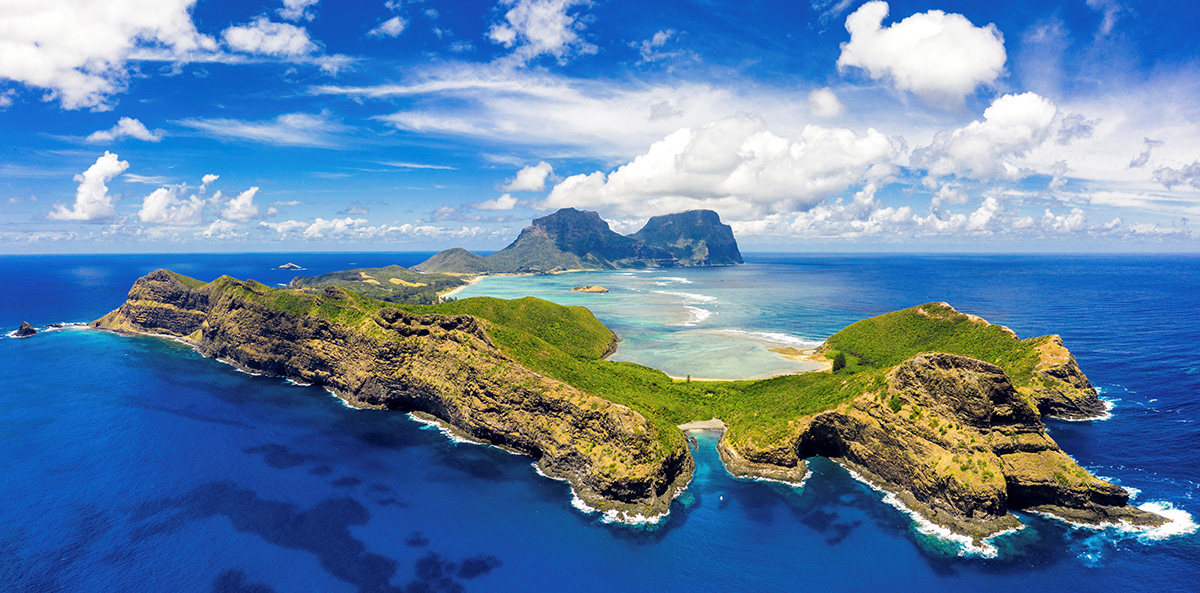
Off the coast of New South Wales, Lord Howe Island has a permanent population of just 360, and daily visitor numbers are capped at 400. And you’ll be one of the lucky few when journeying here for lunch with Crooked Compass by Air. Before touching down at the petite airport, your private charter plane will circle over record-breaking Ball’s Pyramid, a dramatic hunk of basalt that, at 562 metres high, happens to be the world’s tallest sea stack.
After wheels down on Lord itself, enjoy the morning exploring a setting so untamed and otherworldly that it’s earned a UNESCO listing for natural beauty. Its Jurassic-like landscapes of soaring sea cliffs and tangled jungle serve as the breeding ground for 14 species of seabirds, not to mention 130 permanent and migratory bird species—among them the endemic Lord Howe Island woodhen, saved from extinction by local conservation efforts. They flutter between unspoiled and empty beaches, swirl over the towering kentia palm-clad peaks of Gower and Lidgbird, and swoop low across a crystal-clear lagoon protected by the planet’s most southern barrier reef—you can take a dip here with green and hawksbill turtles, bottlenose dolphins and all manner of fish after lunch. But first, the food.
Your dining venue is Anchorage Restaurant, helmed by executive chef David Chlumsky, who earned his stripes at applauded Sydney restaurants Quay, Otto and Longrain. On Lord Howe, Chlumsky’s mod-Australian menu is produce-driven and seasonal, utilising the best of the island and its surrounds, whether organic fruit and vegetables or sustainably caught seafood.
Dust off the crumbs and decide how to spend your afternoon: gliding about the lagoon in a glass-bottom boat, snorkelling over immense coral bommies to explore shipwrecks in the company of huge schools of Moorish idols, or wandering along the sand being entertained by chattering terns and shearwaters. You’re just here for the day—your private charter plane awaits to whisk you and your entourage of seven back to the mainland in time for dinner.
Subscribe to the Newsletter
Recommended for you
For Peat’s Sake: Scotland’s ‘Whisky Island’
There’s a reason Islay produces some of the world’s most characterful whisky. And it’s hidden in the undergrowth.
By Nick Ryan
July 22, 2024
How Paris’s Dining, Hotel and Art Scene Got Their Groove Back — Just in Time for the Olympics
The French capital’s cultural life was already on the upswing. Mix in a major global sporting event, and it’s now ready to go toe to toe with any city in the world.
By Vivian Song
July 9, 2024
You may also like.
By Josh Bozin
24/07/2024
You may also like.
5 Lounge Chairs That Add Chic Seating to Your Space
Daybeds, the most relaxed of seating solutions, offer a surprising amount of utility.
Chaise longue, daybed, recamier, duchesse brisée—elongated furniture designed for relaxing has a roster of fancy names. While the French royal court of Louis XIV brought such pieces to prominence in fashionable European homes, the general idea has been around far longer: The Egyptian pharaohs were big fans, while daybeds from China’s Ming dynasty spurred all those Hollywood Regency fretwork pieces that still populate Palm Beach living rooms. Even Mies van der Rohe, one of design’s modernist icons, got into the lounge game with his Barcelona couch, a study of line and form that holds up today.
But don’t get caught up in who invented them, or what to call them. Instead, consider their versatility: Backless models are ideal in front of large expanses of glass (imagine lazing on one with an ocean view) or at the foot of a bed, while more structured pieces can transform any corner into a cozy reading nook. Daybeds may be inextricably linked to relaxation, but from a design perspective, they put in serious work.

Emmy, Egg Collective
In designing the Emmy chaise, the Egg Collective trio of Stephanie Beamer, Crystal Ellis and Hillary Petrie, who met as students at Washington University in St. Louis, aimed for versatility. Indeed, the tailored chaise looks equally at home in a glass skyscraper as it does in a turn-of-the-century town house. Combining the elegance of a smooth, solid oak or walnut frame with the comfort of bolsters and cushioned upholstery or leather, it works just as well against a wall or at the heart of a room. From around $7,015; Eggcollective.com
 Plum, Michael Robbins
Plum, Michael Robbins
Woodworker Michael Robbins is the quintessential artisan from New York State’s Hudson Valley in that both his materials and methods pay homage to the area. In fact, he describes his style as “honest, playful, elegant and reflective of the aesthetic of the Hudson Valley surroundings”. Robbins crafts his furniture by hand but allows the wood he uses to help guide the look of a piece. (The studio offers eight standard finishes.) The Plum daybed, brought to life at Robbins’s workshop, exhibits his signature modern rusticity injected with a hint of whimsy thanks to the simplicity of its geometric forms. Around $4,275; MichaelRobbins.com

Kimani, Reda Amalou Design
French architect and designer Reda Amalou acknowledges the challenge of creating standout seating given the number of iconic 20th-century examples already in existence. Still, he persists—and prevails. The Kimani, a bent slash of a daybed in a limited edition of eight pieces, makes a forceful statement. Its leather cushion features a rolled headrest and rhythmic channel stitching reminiscent of that found on the seats of ’70s cars; visually, these elements anchor the slender silhouette atop a patinated bronze base with a sure-handed single line. The result: a seamless contour for the body. Around $33,530; RedaAmalou
Dune, Workshop/APD
From a firm known for crafting subtle but luxurious architecture and interiors, Workshop/APD’s debut furniture collection is on point. Among its offerings is the leather-wrapped Dune daybed. With classical and Art Deco influences, its cylindrical bolsters are a tactile celebration, and the peek of the curved satin-brass base makes for a sensual surprise. Associate principal Andrew Kline notes that the daybed adeptly bridges two seating areas in a roomy living space or can sit, bench-style, at the foot of a bed. From $13,040; Workshop/ APD
Sherazade, Edra
Designed by Francesco Binfaré, this sculptural, minimalist daybed—inspired by the rugs used by Eastern civilizations—allows for complete relaxation. Strength combined with comfort is the name of the game here. The Sherazade’s structure is made from light but sturdy honeycomb wood, while next-gen Gellyfoam and synthetic wadding aid repose. True to Edra’s amorphous design codes, it can switch configurations depending on the user’s mood or needs; for example, the accompanying extra pillows—one rectangular and one cylinder shaped— interchange to become armrests or backrests. From $32,900; Edra
You may also like.
By Josh Bozin
24/07/2024
22/07/2024
Watches & Wonders 2024 Showcase: Hermès
We head to Geneva for the Watches & Wonders exhibition; a week-long horological blockbuster featuring the hottest new drops, and no shortage of hype.
With Watches & Wonders 2024 well and truly behind us, we review some of the novelties Hermès presented at this year’s event.
—
HERMÈS

Moving away from the block colours and sporty aesthetic that has defined Hermès watches in recent years, the biggest news from the French luxury goods company at Watches & Wonders came with the unveiling of its newest collection, the Hermès Cut.
It flaunts a round bezel, but the case middle is nearer to a tonneau shape—a relatively simple design that, despite attracting flak from some watch aficionados, works. While marketed as a “women’s watch”, the Cut has universal appeal thanks to its elegant package and proportions. It moves away from the Maison’s penchant for a style-first product; it’s a watch that tells the time, not a fashion accessory with the ability to tell the time.
Hermès gets the proportions just right thanks to a satin-brushed and polished 36 mm case, PVD-treated Arabic numerals, and clean-cut edges that further accentuate its character. One of the key design elements is the positioning of the crown, boldly sitting at half-past one and embellished with a lacquered or engraved “H”, clearly stamping its originality. The watch is powered by a Hermès Manufacture movement H1912, revealed through its sapphire crystal caseback. In addition to its seamlessly integrated and easy-wearing metal bracelet, the Cut also comes with the option for a range of coloured rubber straps. Together with its clever interchangeable system, it’s a cinch to swap out its look.
It will be interesting to see how the Hermès Cut fares in coming months, particularly as it tries to establish its own identity separate from the more aggressive, but widely popular, Ho8 collection. Either way, the company is now a serious part of the dialogue around the concept of time.
—
Read more about this year’s Watches & Wonders exhibition at robbreport.com.au
You may also like.
22/07/2024
Living La Vida Lagerfeld
The world remembers him for fashion. But as a new tome reveals, the iconoclastic designer is defined as much by extravagant, often fantastical, homes as he is clothes.
“Lives, like novels, are made up of chapters”, the world-renowned bibliophile, Karl Lagerfeld, once observed.
Were a psychological-style novel ever to be written about Karl Lagerfeld’s life, it would no doubt give less narrative weight to the story of his reinvigoration of staid fashion houses like Chloe, Fendi and Chanel than to the underpinning leitmotif of the designer’s constant reinvention of himself.
In a lifetime spanning two centuries, Lagerfeld made and dropped an ever-changing parade of close friends, muses, collaborators and ambiguous lovers, as easily as he changed his clothes, his furniture… even his body. Each chapter of this book would be set against the backdrop of one of his series of apartments, houses and villas, whose often wildly divergent but always ultra-luxurious décor reflected the ever-evolving personas of this compulsively public but ultimately enigmatic man.
With the publication of Karl Lagerfeld: A Life in Houses these wildly disparate but always exquisite interiors are presented for the first time together as a chronological body of work. The book indeed serves as a kind of visual novel, documenting the domestic dreamscapes in which the iconic designer played out his many lives, while also making a strong case that Lagerfeld’s impact on contemporary interior design is just as important, if not more so, than his influence on fashion.

In fact, when the first Lagerfeld interior was featured in a 1968 spread for L’OEil magazine, the editorial describes him merely as a “stylist”. The photographs of the apartment in an 18th-century mansion on rue de Université, show walls lined with plum-coloured rice paper, or lacquered deepest chocolate brown in sharp contrast to crisp, white low ceilings that accentuated the horizontality that was fashionable among the extremely fashionable at the time. Yet amid this setting of aggressively au courant modernism, the anachronistic pops of Art Nouveau and Art Deco objects foreshadow the young Karl’s innate gift for creating strikingly original environments whose harmony is achieved through the deft interplay of contrasting styles and contexts.
Lagerfeld learned early on that presenting himself in a succession of gem-like domestic settings was good for crafting his image. But Lagerfeld’s houses not only provided him with publicity, they also gave him an excuse to indulge in his greatest passion. Shopping!
By 1973, Lagerfeld was living in a new apartment at Place Saint–Sulpice where his acquisition of important Art Deco treasures continued unabated. Now a bearded and muscular disco dandy, he could most often be found in the louche company of the models, starlets and assorted hedonistic beauties that gathered around the flamboyant fashion illustrator Antonio Lopez. Lagerfeld was also in the throes of a hopeless love affair with Jacques de Bascher whose favours he reluctantly shared with his nemesis Yves Saint Laurent.

He painted the rooms milky white and lined them with specially commissioned carpets—the tawny patterned striations of which invoked musky wild animal pelts. These lent a stark relief to the sleek, machine-age chrome lines of his Deco furnishings. To contemporary eyes it remains a strikingly original arrangement that subtly conveys the tensions at play in Lagerfeld’s own life: the cocaine fuelled orgies of his lover and friends, hosted in the pristine home of a man who claimed that “a bed is for one person”.
In 1975, a painful falling out with his beloved Jacques, who was descending into the abyss of addiction, saw almost his entire collection of peerless Art Deco furniture, paintings and objects put under the auctioneer’s hammer. This was the first of many auction sales, as he habitually shed the contents of his houses along with whatever incarnation of himself had lived there. Lagerfeld was dispassionate about parting with these precious goods. “It’s collecting that’s fun, not owning,” he said. And the reality for a collector on such a Renaissance scale, is that to continue buying, Lagerfeld had to sell.
Of all his residences, it was the 1977 purchase of Hôtel Pozzo di Borgo, a grand and beautifully preserved 18th-century house, that would finally allow him to fulfill his childhood fantasies of life in the court of Madame de Pompadour. And it was in this aura of Rococó splendour that the fashion designer began to affect, along with his tailored three-piece suits, a courtier’s ponytailed and powdered coif and a coquettish antique fan: marking the beginning of his transformation into a living, breathing global brand that even those with little interest in fashion would immediately recognise.

Lagerfeld’s increasing fame and financial success allowed him to indulge in an unprecedented spending frenzy, competing with deep-pocketed institutions like the Louvre to acquire the finest, most pedigreed pearls of the era—voluptuously carved and gilded bergères; ormolu chests; and fleshy, pastel-tinged Fragonard idylls—to adorn his urban palace. His one-time friend André Leon Talley described him in a contemporary article as suffering from “Versailles complex”.
However, in mid-1981, and in response to the election of left-wing president, François Mitterrand, Lagerfeld, with the assistance of his close friend Princess Caroline, became a resident of the tax haven of Monaco. He purchased two apartments on the 21st floor of Le Roccabella, a luxury residential block designed by Gio Ponti. One, in which he kept Jacques de Bascher, with whom he was now reconciled, was decorated in the strict, monochromatic Viennese Secessionist style that had long underpinned his aesthetic vocabulary; the other space, though, was something else entirely, cementing his notoriety as an iconoclastic tastemaker.

Lagerfeld had recently discovered the radically quirky designs of the Memphis Group led by Ettore Sottsass, and bought the collective’s entire first collection and had it shipped to Monaco. In a space with no right angles, these chaotically colourful, geometrically askew pieces—centred on Masanori Umeda’s famous boxing ring—gave visitors the disorientating sensation of having entered a corporeal comic strip. By 1991, the novelty of this jarring postmodern playhouse had inevitably worn thin and once again he sent it all to auction, later telling a journalist that “after a few years it was like living in an old Courrèges. Ha!”

In 1989, de Bascher died of an AIDS-related illness, and while Lagerfeld’s career continued to flourish, emotionally the famously stoic designer was struggling. In 2000, a somewhat corpulent Lagerfeld officially ended his “let them eat cake” years at the Hôtel Pozzo di Borgo, selling its sumptuous antique fittings in a massive headline auction that stretched over three days. As always there were other houses, but now with his longtime companion dead, and his celebrity metastasising making him a target for the paparazzi, he began to look less for exhibition spaces and more for private sanctuaries where he could pursue his endless, often lonely, work.
His next significant house was Villa Jako, named for his lost companion and built in the 1920s in a nouveau riche area of Hamburg close to where he grew up. Lagerfeld shot the advertising campaign for Lagerfeld Jako there—a fragrance created in memorial to de Bascher. The house featured a collection of mainly Scandinavian antiques, marking the aesthetic cusp between Art Nouveau and Art Deco. One of its rooms Lagerfeld decorated based on his remembrances of his childhood nursery. Here, he locked himself away to work—tellingly—on a series of illustrations for the fairy tale, The Emperor’s New Clothes. Villa Jako was a house of deep nostalgia and mourning.
But there were more acts—and more houses—to come in Lagerfeld’s life yet. In November 2000, upon seeing the attenuated tailoring of Hedi Slimane, then head of menswear at Christian Dior, the 135 kg Lagerfeld embarked on a strict dietary regime. Over the next 13 months, he melted into a shadow of his former self. It is this incarnation of Lagerfeld—high white starched collars; Slimane’s skintight suits, and fingerless leather gloves revealing hands bedecked with heavy silver rings—that is immediately recognisable some five years after his death.
The 200-year-old apartment in Quái Voltaire, Paris, was purchased in 2006, and after years of slumber Lagerfeld—a newly awakened Hip Van Winkle—was ready to remake it into his last modernist masterpiece. He designed a unique daylight simulation system that meant the monochromatic space was completely without shadows—and without memory. The walls were frosted and smoked glass, the floors concrete and silicone; and any hint of texture was banned with only shiny, sleek pieces by Marc Newson, Martin Szekely and the Bouroullec Brothers permitted. Few guests were allowed into this monastic environment where Lagerfeld worked, drank endless cans of Diet Coke and communed with Choupette, his beloved Birman cat, and parts of his collection of 300,000 books—one of the largest private collections in the world.

Lagerfeld died in 2019, and the process of dispersing his worldly goods is still ongoing. The Quái Voltaire apartment was sold this year for US$10.8 million (around $16.3 million). Now only the rue de Saint-Peres property remains within the Lagerfeld trust. Purchased after Quái Voltaire to further accommodate more of his books—35,000 were displayed in his studio alone, always stacked horizontally so he could read the titles without straining his neck—and as a place for food preparation as he loathed his primary living space having any trace of cooking smells. Today, the rue de Saint-Peres residence is open to the public as an arts performance space and most fittingly, a library.
You may also like.
By Josh Bozin
24/07/2024
Watch This Space: Mike Nouveau
Meet the game-changing horological influencers blazing a trail across social media—and doing things their own way.
In the thriving world of luxury watches, few people own a space that offers unfiltered digital amplification. And that’s precisely what makes the likes of Brynn Wallner, Teddy Baldassarre, Mike Nouveau and Justin Hast so compelling.
These thought-provoking digital crusaders are now paving the way for the story of watches to be told, and shown, in a new light. Speaking to thousands of followers on the daily—mainly via TikTok, Instagram and YouTube—these progressive commentators represent the new guard of watch pundits. And they’re swaying the opinions, and dollars, of the up-and-coming generations who now represent the target consumer of this booming sector.
—
MIKE NOUVEAU

Can we please see what’s on the wrist? That’s the question that catapulted Mike Nouveau into watch stardom, thanks to his penchant for highlighting incredibly rare timepieces across his TikTok account of more than 400,000 followers. When viewing Nouveau’s attention-grabbing video clips—usually shot in a New York City neighbourhood—it’s not uncommon to find him wrist-rolling some of the world’s rarest timepieces, like the million-dollar Cartier Cheich (a clip he posted in May).
But how did someone without any previous watch experience come to amass such a cult following, and in the process gain access to some of the world’s most coveted timepieces? Nouveau admits had been a collector for many years, but moved didn’t move into horology full-time until 2020, when he swapped his DJing career for one as a vintage watch specialist.
“I probably researched for a year before I even bought my first watch,” says Nouveau, alluding to his Rolex GMT Master “Pepsi” ref. 1675 from 1967, a lionised timepiece in the vintage cosmos. “I would see deals arise that I knew were very good, but they weren’t necessarily watches that I wanted to buy myself. I eventually started buying and selling, flipping just for fun because I knew how to spot a good deal.”
Nouveau claims that before launching his TikTok account in the wake of Covid-19, no one in the watch community knew he existed. “There really wasn’t much watch content, if any, on TikTok before I started posting, especially talking about vintage watches. There’s still not that many voices for vintage watches, period,” says Nouveau. “It just so happens that my audience probably skews younger, and I’d say there are just as many young people interested in vintage watches as there are in modern watches.”
View this post on Instagram
Nouveau recently posted a video to his TikTok account revealing that the average price of a watch purchased by Gen Z is now almost US$11,000 (around $16,500), with 41 percent of them coming into possession of a luxury watch in the past 12 months.
“Do as much independent research as you can [when buying],” he advises. “The more you do, the more informed you are and the less likely you are to make a mistake. And don’t bring modern watch expectations to the vintage world because it’s very different. People say, ‘buy the dealer’, but I don’t do that. I trust myself and myself only.”
—
Read more about the influencers shaking up horology here with Justin Hast, Brynn Wallner and Teddy Baldassare.
You may also like.
By Josh Bozin
24/07/2024
This Pristine 1960 Ferrari 250 Spider Could Fetch $24 Million at Auction
The car wears the same colours and has the same engine it left the factory with.
Some Ferraris are just a little bit more important than others.
Take, for example, the 1960 250 GT SWB California that RM Sotheby’s is auctioning off during this year’s Monterey Car Week. Any example of the open-top beauty would attract interest, but this one just so happens to be the first one that was built.
The 250 is one of the most legendary series of cars in Ferrari history. Between 1952 and 1964, the company released 21 different 250 models—seven for racetracks, 14 for public roads—of which the “Cali Spider” might be the most well regarded, thanks to its potent V-12 and a Pininfarina-penned design that is one of the most beautiful bodies to grace an automobile. The roadster, which was specifically built for the U.S., made its debut in 1957 as a long-wheel-base model (LWB), but it wasn’t until the SWB model debut in 1960 that it became clear how special it was. This example isn’t just the first to roll off the line. It’s the actual car that was used to introduce the world to the model at the 1960 Geneva Motor Show.

Just 56 examples of the 250 GT SWB California Spider would be built by Scaglietti during the three years it was in production. The first of those, chassis 1795 GT, is finished in a glossy coat of Grigio. The two-door had a red leather interior at Geneva but was returned to the factory and re-outfitted with black leather upholstery before being delivered to its original owner, British race car driver John Gordon Bennet. Six-and-a-half decades later the car looks identical to how it did when it left the factory the second time.

In addition to its original bodywork, the chassis 1795 GT features its original engine, gearbox, and rear axle. That mill is the competition-spec Tipo 168, a 3.0-litre V-12 that makes 196.1 kW. That may not sound like much by today’s standards, but, when you consider that the 250 GT SWB California Spider tips the scales around 952 kilograms, it’s more than enough.

The first 250 GT SWB California Spider is scheduled to go up for bid during RM Sotheby’s annual Monterey Car Week auction, which runs from Thursday, August 15, to Saturday, August 17. Unsurprisingly, the house has quite high hopes for the car. The car carries an estimate of between $24 million and $26 million, which could make it one of the most expensive cars ever sold at auction.

You may also like.
By Josh Bozin
24/07/2024






